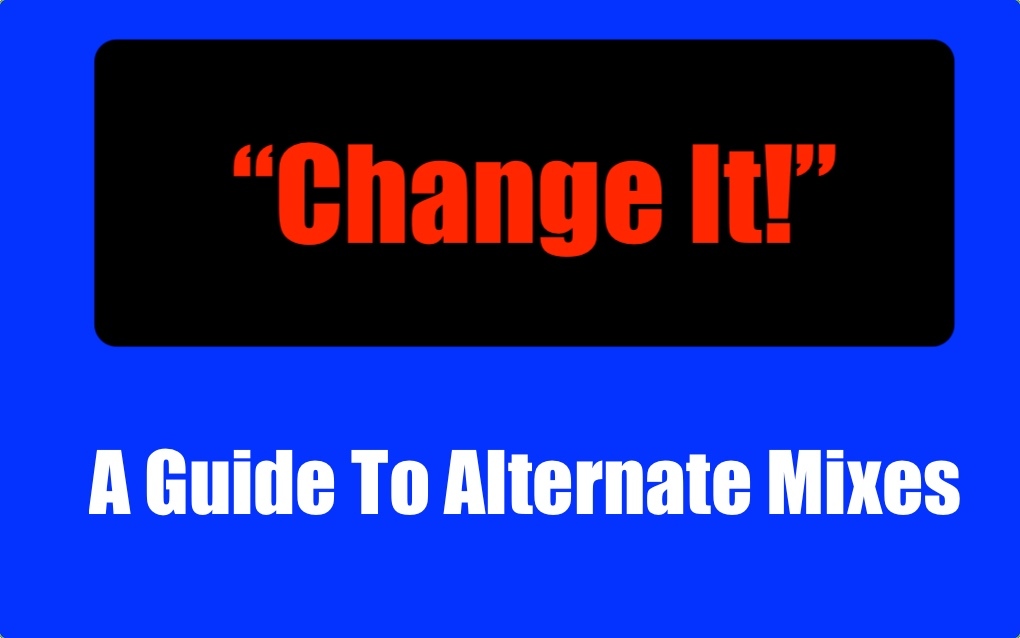- in Production by Bobby Owsinski
- |
- 1 comments
A Guide To Alternate Mixes

Until most engineers joined the DAW revolution, alternate mixes were a way of life for the mixer to cover himself in case a change in the mix was deemed necessary at a later time. Renting the studio and then setting up an analog console and all of the outboard gear just to raise the vocal 1dB in the bridge was both expensive and a time- consuming hassle. Plus, the setup was so inaccurate that the mix might not sound the same. All that changed with DAWs.
Now that so many mixers choose to mix at least partially in the box, mixes can be instantly recalled and fixes done in a matter of minutes. It’s fast, cheap, and easy, and as a result, alternate mixes are no longer the norm except for the analog diehards. That said, it’s important to understand about the most commonly used alternate mixes, because a producer or record label may still ask for them.
“There are just never enough options for some people. When you deal with major labels and managers, there’s constantly this thing of, ‘Can we get one with this in the second verse?’, so I supply many levels of vocal up and vocal down.”
—Joe Chiccarelli
Different Types of Alternate Mixes
Alternate mixes were originally done to avoid having to redo the mix again at a later time because a change in the level of a mix element was requested. This means that any element that might later be questioned, such as a lead vocal, solo instrument, background vocals, or any other major part, was mixed with that part recorded slightly louder and again slightly softer. This is referred to as the up mix and the down mix. These increments are very small; 0.5dB to 1.5dB, but usually not much more.
With alternate mixes available, it’s also possible to correct an otherwise perfect mix later by editing in a masked word or a chorus with louder background vocals. Many times an instrumental mix is used to splice out objectionable language, especially in the rap and hip-hop worlds.
Although many record companies ask for more or different versions, here’s a version list for a mix that the label for a rock or country artist might ask for. Other types of music will have a similar version list that’s appropriate for the genre.
- Album Version
- Album Version with Vocals Up
- Contemporary Hits Radio Mix (softer guitars)
- Album-Oriented Radio Mix (more guitars and more drums)
- Adult Contemporary Mix (minimum guitars, maximum keyboards and orchestration)
- TV Mix (minus the lead vocal)
- Vocals-Only Mix
The band, producer, or record label may also ask for additional versions, such as a pass without delays on the vocals in the chorus, more guitars in the vamp, or a version with the bass up. There is also a good chance that any singles will need a shortened radio edit as well.
Thanks to the virtues of the digital audio workstation and modern console automation, many engineers leave the up and down mixes to the assistants, since most of the hard work is already done.
Stems
In extreme cases, some mixers have resorted to the use of “stems” to keep everyone (mostly the record company) happy. A stems mix is a set of stereo submix files that usually consists of a stereo bed track and individual stereo tracks of the most important elements complete with effects. This allows for an easy remix later if it’s decided that the balance of the lead vocal or the solo is wrong.
Stems are widely used in film mixing because a music mixer usually can’t tell what may be too loud or masked by the dialog or sound-effects elements of the movie. The stems mix gives the dubbing mixer more control during the final mix if required. It’s typical for the dubbing stage to ask for a stereo (or even surround) rhythm submix, a submix of any lead instruments or voices with effects, the bass by itself, and any instruments with a lot of high frequencies, all isolated on their own submix.
You can read more from The Mixing Engineer’s Handbook and my other books on the excerpt section of bobbyowsinski.com.

